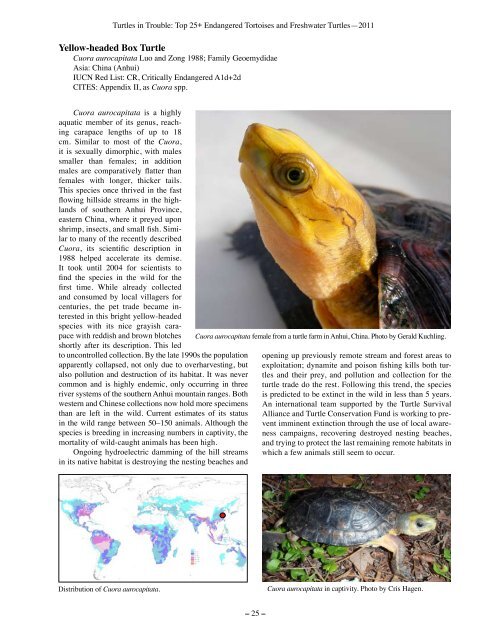Turtles in Trouble: The World's 25+ Most Endangered - Wildlife ...
Turtles in Trouble: The World's 25+ Most Endangered - Wildlife ...
Turtles in Trouble: The World's 25+ Most Endangered - Wildlife ...
- No tags were found...
You also want an ePaper? Increase the reach of your titles
YUMPU automatically turns print PDFs into web optimized ePapers that Google loves.
<strong>Turtles</strong> <strong>in</strong> <strong>Trouble</strong>: Top <strong>25+</strong> <strong>Endangered</strong> Tortoises and Freshwater <strong>Turtles</strong>—2011Yellow-headed Box TurtleCuora aurocapitata Luo and Zong 1988; Family GeoemydidaeAsia: Ch<strong>in</strong>a (Anhui)IUCN Red List: CR, Critically <strong>Endangered</strong> A1d+2dCITES: Appendix II, as Cuora spp.Cuora aurocapitata is a highlyaquatic member of its genus, reach<strong>in</strong>gcarapace lengths of up to 18cm. Similar to most of the Cuora,it is sexually dimorphic, with malessmaller than females; <strong>in</strong> additionmales are comparatively flatter thanfemales with longer, thicker tails.This species once thrived <strong>in</strong> the fastflow<strong>in</strong>g hillside streams <strong>in</strong> the highlandsof southern Anhui Prov<strong>in</strong>ce,eastern Ch<strong>in</strong>a, where it preyed uponshrimp, <strong>in</strong>sects, and small fish. Similarto many of the recently describedCuora, its scientific description <strong>in</strong>1988 helped accelerate its demise.It took until 2004 for scientists tof<strong>in</strong>d the species <strong>in</strong> the wild for thefirst time. While already collectedand consumed by local villagers forcenturies, the pet trade became <strong>in</strong>terested<strong>in</strong> this bright yellow-headedspecies with its nice grayish carapacewith reddish and brown blotchesshortly after its description. This ledto uncontrolled collection. By the late 1990s the populationapparently collapsed, not only due to overharvest<strong>in</strong>g, butalso pollution and destruction of its habitat. It was nevercommon and is highly endemic, only occurr<strong>in</strong>g <strong>in</strong> threeriver systems of the southern Anhui mounta<strong>in</strong> ranges. Bothwestern and Ch<strong>in</strong>ese collections now hold more specimensthan are left <strong>in</strong> the wild. Current estimates of its status<strong>in</strong> the wild range between 50–150 animals. Although thespecies is breed<strong>in</strong>g <strong>in</strong> <strong>in</strong>creas<strong>in</strong>g numbers <strong>in</strong> captivity, themortality of wild-caught animals has been high.Ongo<strong>in</strong>g hydroelectric damm<strong>in</strong>g of the hill streams<strong>in</strong> its native habitat is destroy<strong>in</strong>g the nest<strong>in</strong>g beaches andCuora aurocapitata female from a turtle farm <strong>in</strong> Anhui, Ch<strong>in</strong>a. Photo by Gerald Kuchl<strong>in</strong>g.open<strong>in</strong>g up previously remote stream and forest areas toexploitation; dynamite and poison fish<strong>in</strong>g kills both turtlesand their prey, and pollution and collection for theturtle trade do the rest. Follow<strong>in</strong>g this trend, the speciesis predicted to be ext<strong>in</strong>ct <strong>in</strong> the wild <strong>in</strong> less than 5 years.An <strong>in</strong>ternational team supported by the Turtle SurvivalAlliance and Turtle Conservation Fund is work<strong>in</strong>g to preventimm<strong>in</strong>ent ext<strong>in</strong>ction through the use of local awarenesscampaigns, recover<strong>in</strong>g destroyed nest<strong>in</strong>g beaches,and try<strong>in</strong>g to protect the last rema<strong>in</strong><strong>in</strong>g remote habitats <strong>in</strong>which a few animals still seem to occur.Distribution of Cuora aurocapitata.Cuora aurocapitata <strong>in</strong> captivity. Photo by Cris Hagen.– 25 –







![RaLand / SeaScape [PDF] - Wildlife Conservation Society](https://img.yumpu.com/49974326/1/190x245/raland-seascape-pdf-wildlife-conservation-society.jpg?quality=85)








